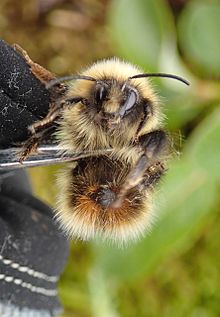|
Bombus balteatus
Bombus balteatus, the golden-belted bumble bee, is a species of bumblebee with a boreal and high altitude distribution in northern Eurasia and North America. Range and distributionThis species is found in Finland, northern Sweden, Norway, Russia,[3] and North America from arctic Alaska, Canada, and mountain ranges in the United States such as the Sierra Nevada and the White Mountains down south to New Mexico.[4] Their preferred habitat includes high altitude and boreal regions, and they are often found at higher elevations than the tree line.[1] Bombus balteatus is often most abundant where Castilleja, Chrysothammnus, and Mertensia plant species are common.[5] Some populations of bees, including in the Rocky Mountains, specifically Mount Blue Sky, Niwot Ridge and Pennsylvania Mountain have declined in the 21st century. MorphologyBombus balteatus is a long-tongued bumblebee. Often the tongue length reaches two-thirds or more the length of the body.[5] This morphological feature allows them to specialize on flowers with long corollas.[6] In North America, workers can be identified by a distinctive black abdomen pattern and robust body.[5] SystematicsThe most closely related species are Bombus hyperboreus, Bombus frigidus, and Bombus mixtus, which all occur in Western North America and Arctic Europe.[5] Effects of climate changeIn the Rocky Mountains, USA, many native plants species include flowers with elongated corollas. With abundant resources, B. balteatus can be a dominant species in the ecosystem.[7] However, Rocky Mountain bumblebees, including B. balteatus and Bombus sylvicola, have shown changes in abundance and foraging range as long-tubed floral resources are declining at higher altitudes; they have also exhibited a trend towards shorter tongues over the last 40 years.[6] This is indicative of niche expansion; although this species of bumblebee is considered highly specialized, it is now adapting to forage on a broader range of morphologically diverse flowering plants.[6] Immigration by short-tongued bumble bees into higher altitudes, as well as an increase in the number of Bombus balteatus individuals with shorter tongues, has also occurred as a result of warming and climate change. This creates new competition for long-tongued B. balteatus for limited floral resources.[6] References
|
||||||||||||||||||||||||||||||||

